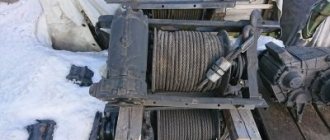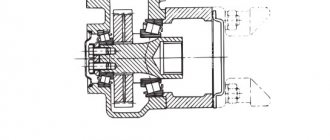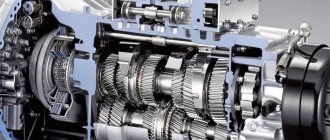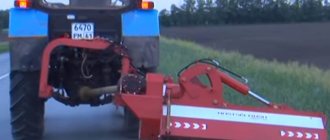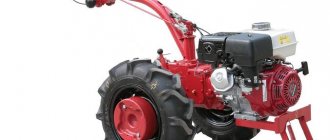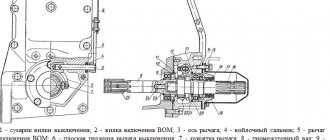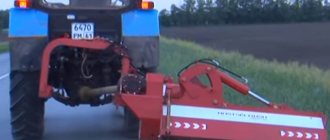Winch and power take-off GAZ-66, GAZ-3308/33081 Sadko, Yeger
Winch
The winch of all-wheel drive cars GAZ-66, 3308, 33081 Sadko, Yeger (Fig. 1) is mounted in the front part of the frame on two angles. The winch is driven by a cardan shaft.
The winch drum 1 is freely mounted on the shaft 8. A steel jaw coupling 3 is installed on the splined part of the shaft, which has the ability to move along the shaft and engage with the drum cams, so that the drum can be connected to the shaft or disconnected from it.
Fig.1. Winch for GAZ-66, GAZ-3308, 33081 cars with gearbox
1-drum winch; 2-brake retarder; 3-clutch; 4-drum fork handle; 5-filler plug; 6-gear; 7-crankcase; 8-shaft winch; 9-brake housing; 10-safety finger; 11-cardan fork; 12-automatic brake; 13-brake housing cover; 14- worm; 15-drain plug; 16-control plug; 17-oil seal; 18-cable
The clutch is turned on and off by means of a fork, which is equipped with a brake 2, which slows down the drum while unwinding the cable by hand. When the clutch is disengaged, the brake shoe (with the friction lining) is pressed against the drum flange, braking it.
The jaw coupling must remain in engagement with the drum jaws at all times, except when the winch cable is being unwinded by hand.
The GAZ-33081, 3308, 66 Sadko winch has an automatic brake 12, designed for additional braking of the winch gearbox worm when the clutch is disengaged, and also after the safety pin is cut off. The brake device is shown in Fig. 2.
Fig.2. Automatic winch brake for GAZ-66, 3308, 33081 cars
1-brake band tip; 2-nut and locknut; 3-spring; 4-brake drum; 5-worm 6-brake band
When winding the cable, the brake drum 4 rotates so that even the slightest friction of the brake band 6 on the drum causes compression of the spring 3 and weakens the tension of the band, creating conditions for free rotation of the drum.
When the safety pin is cut, the winch gearbox worm tends to rotate in the opposite direction. The friction force of the brake band will be directed towards the action of spring 3.
The tape is tightened, preventing the rotation of drum 4. When unwinding the cable under load (descent from a steep slope using a winch), the worm rotates in the same way, which creates a frictional moment on its drum, but in this case it is overcome by the supplied torque of the engine.
Do not unwind the cable completely from the drum, so as not to overload the cable termination. It is necessary to leave 3-4 turns of the cable on the drum. The end of the cable is sealed with a stepladder installed in the casting boss of the drum. Protrusion of a stepladder into the inner cavity of the drum is not allowed.
The cable must be unwinded manually by turning off the winch clutch. It is permissible to use a gear to unwind the cable; in this case, the cable must be tightened manually.
To protect the GAZ-3308, 33081, 66 winch from overloads, the gearbox worm shaft is connected to the universal joint fork using safety pin 10 (see Fig. 1). When the winch is overloaded, the finger is cut off, and the drum is stopped by an automatic brake installed on the worm shaft.
After cutting off the safety pin, you must immediately depress the clutch and turn off the power take-off, as otherwise the fork may jam on the shaft. The cut off finger must be replaced with a new one (the fingers are attached to the car). It is strictly prohibited to use bolts or other objects instead of a safety pin.
It should be borne in mind that if, when pulling the winch over a large radius of winding the cable on the drum (“full” drum), its traction force is not enough (the safety pins are cut off), then by unwinding the cable, you can increase the traction force.
In this case, when pulling out a car by yourself, you need to select a more distant support for the cable hook, and when pulling out another car, move the car with the winch back.
To guide the cable, a guide device is placed in the cutout of the front bumper of the car, which serves to ensure even laying of the cable and consists of one horizontal lower and two vertical side rollers.
To pull out a foreign stuck car, a winch block is attached to the car, designed to give the cable a perpendicular direction in a horizontal plane relative to the axis of the drum.
In order to insert the cable into the stream of the GAZ-66, 3308, 33081 Sadko winch block, it is necessary to unpin the block axis and the hook traverse from the side of the removable shackle and remove the shackle. After the cable is inserted into the stream, put the earring in place, secure the block axle and traverse.
The block is secured using the vehicle's tow rope. To pull out stuck cars, engage only the power take-off. In addition, it is necessary to put the gear lever in neutral, brake the car with the parking brake, engage the clutch and slightly increase the engine speed.
To self-extract the car, engage the front axle, downshift in the transfer case, power take-off and first gear in the gearbox. Engage the clutch and give the engine a medium speed by pressing the throttle pedal.
To release and loosen the tensioned cable of the GAZ-66, 3308, 33081 winch, you must:
– turn on “unwinding” in the power take-off;
– place the gear lever in neutral position;
– smoothly engage the clutch (there is no need to increase the engine speed when releasing the cable).
To stop the winch, you need to disengage the clutch and put the power take-off lever in the neutral position. After finishing work with the winch, the power take-off lever should be secured in the neutral position with a hinged stop loop.
To avoid overheating of the oil in the gearbox (over 130°) in cases where long-term operation of the winch is required, it is necessary to take breaks to reduce the oil temperature after continuous pulling up to a total cable length of 70 m.
Power take-off for GAZ-66, GAZ-3308, GAZ-33081 Sadko cars
The power take-off of GAZ-66, 3308, 33081 Sadko cars is used to transmit torque from the gearbox through the universal joint and gearbox to the winch drum.
It is mounted on the gearbox on the right side and has two gears: one for winding the cable onto the winch drum and the other for unwinding the cable.
The gear ratio of the power take-off (from the engine) is 2.41—winding and 1.7—unwinding. The drive gear 12 (Fig. 3) is constantly engaged with the third gear of the intermediate shaft of the gearbox and the gear block of the intermediate shaft 11 of the power take-off.
Fig.3. Power take-off GAZ-33081, 3308, 66
1—shift lever; 2—drain plug; 3—front cover; 4—rod; 5—retainer ball; 6 — crankcase; 7—fork; 8—back cover; 9—secondary shaft; 10 — gear block; 11-intermediate shaft; 12—drive gear; 13—axis
The inclusion of one or another gear in the GAZ-66, 3308, 33081 Sadko power take-off is carried out by moving the sliding block of gears 10 of the secondary shaft 9. When the “winding” gear is engaged, the sliding block 10 is engaged with the gear block of the intermediate shaft in the “unwinding” gear - directly with drive gear 12.
The power take-off is controlled from the driver's seat by lever 1, connected by means of a pin to rod 4 of the fork 7. Three recesses on rod 4 serve to fix the engagement of both gears and disengagement of the power take-off. The retainer consists of a ball 5 and a spring placed in the lug of the box housing.
To prevent accidental engagement of gears, the power take-off lever is locked in the neutral position by a special folding stop loop installed on the floor of the vehicle's cabin.
The vehicle's power take-off mechanisms are lubricated by oil poured into the gearbox. It must be remembered that when draining the oil from the gearbox, be sure to drain the oil from the power take-off box by unscrewing drain plug 2.
contents .. 71 72 ..GAZ-66-11. Winch (device)
The winch (Fig. 172) is mounted in the front part of the frame on two angles. The winch is driven by two cardan shafts from the power take-off. The gear ratio of the worm gear of the winch gearbox is 24.
The winch drum 1 is freely mounted on shaft 8. A steel jaw coupling 3 is installed on the splined part of the shaft, which has the ability to move along the shaft and engage with the drum cams, due to which the drum can be connected to the shaft or disconnected from it. Turns on
and the clutch is disengaged by means of a fork, which is equipped with a brake 2, which slows down the drum while unwinding the cable by hand. When the clutch is disengaged, the brake shoe (with the friction lining) is pressed against the drum flange, braking it. The jaw coupling must remain in mesh with the drum jaws at all times, except when the winch cable is being unwinded by hand. The winch has an automatic brake 12, designed for additional braking of the winch gearbox worm when the clutch is disengaged, and also after the safety pin is cut off. The brake device is shown in Fig. 173.
When winding the cable, the brake drum 4 rotates so that even the slightest friction of the brake band 6 on the drum causes compression of the spring 3 and weakens the tension of the band, creating conditions for free rotation of the drum.
When the safety pin is cut off, the gearbox worm tends to rotate in the opposite direction. The frictional force of the brake band is directed towards the action of spring 3. The band is tightened, preventing the rotation of drum 4. When unwinding the cable under load (descent from a steep slope using a winch), the worm rotates in the same way, which creates a frictional moment on its drum, but in this case it is overcome by the supplied torque of the engine.
To protect the winch from overloads, the gearbox worm shaft is connected to the universal joint fork using safety pin 10 (see Fig. 172). When the winch is overloaded, the finger is cut off, and the drum is stopped by an automatic brake installed on the worm shaft.
The dimensions of the mating parts of the winch are indicated in the appendix. 2.
Rice. 172. Winch with gearbox: 1—winch drum; 2—retarder; 3—coupling; 4—drum fork handle; 5—filler plug; 6— gear; 7—crankcase; 8—winch shaft; 9—brake housing; 10—safety finger; 11— universal joint fork; t2—automatic brake; 13—brake housing cover; 14—worm; 15—drain plug; 16—control hole plug; 17—oil seal; 18—cable
GAZ-66-11. Features of maintenance and operation of the winch
Caring for the winch consists of periodically lubricating the cable guide rollers, the shaft spline, the winch drum and the drum clutch, the drive shafts of the winch drive, the drum bushings, and cleaning the winch and its drive from dirt.
Periodically check the oil level in the gearbox housing and, if necessary, add it, and also check whether there is oil (or water) in the automatic brake housing; If present, remove the cotter pin and clear the drain hole at the bottom of the crankcase.
The retarder brake is adjusted as necessary by changing the degree of spring tension using nuts installed on the brake shoe bolt. Adjust so that when winding the cable manually (the cam clutch is turned off), the drum cannot rotate at a speed greater than the speed of winding the cable, i.e., so that the cable on the drum does not weaken. The drum fork stop, located on the front square, is secured so that when the fork is in the engaged position, there is a gap of about 1 mm between its stopper and the stop. To ensure reliable operation of the brake, the rubbing surfaces of the drum pad must not be allowed to become oily.
The automatic brake of the winch is regulated by tightening the brake band with nuts installed on its long tip (above the spring). The brake is adjusted so that during 3...5 minutes of winding operation of the winch, the brake housing cover does not heat up above the temperature that the hand can withstand. When working with a winch, the cable is not completely unwound from the drum, so as not to overload the cable termination. It is necessary to leave 3...4 turns of the cable.
When the safety pin is cut off, immediately depress the clutch and turn off the power take-off, since otherwise the fork may jam on the shaft. The cut off finger is replaced with a new one (the fingers are attached to the car). It is strictly prohibited to use bolts or other objects instead of a safety pin.
In order to insert the cable into the block stream, unsplint the block axis and the hook traverse from the side of the removable shackle and remove the shackle. After the cable is inserted into the stream, the earring is put in place, the block axis and the traverse are secured with cotter pins. Pulling out a car using a winch and a block is shown in Fig. 174. The block is secured using the vehicle's tow rope.
To pull out stuck cars, only the power take-off is turned on. The gearbox lever is placed in neutral, the car is braked with the parking brake, the clutch is engaged and the engine speed is slightly increased.
To pull the car out by itself, turn on the front axle, the reduction gear in the transfer case, the power take-off box and
1st gear in the gearbox. Engage the clutch and give the engine a medium speed. Self-pulling a car using a winch is shown in Fig. 175. To release and loosen the tensioned cable: put the power take-off lever in the “Unwind” position; The gear lever is placed in neutral position; smoothly engage the clutch (when the cable is released, the engine speed is not increased).
To stop the winch, disengage the clutch and place the power take-off lever in the neutral position. After finishing work with the winch, the power take-off lever is secured in the neutral position with a hinged stop loop.
Rice. 173. Automatic winch brake: 1—tip of the brake band; 2—nut and locknut; 3—spring; 4—brake drum; 5—worm; 6—brake band
Rice. 174. Pulling out a car using a winch and a block
Rice. 175. Self-pulling a car using a winch
GAZ-66-11. Possible malfunctions of the winch and methods for eliminating them are given
Winch malfunctions and how to fix them
| Causes of malfunction | Remedies |
| The safety pin is cut off at low loads on the cable | |
| high friction in globoidal gear and excessive wear of the worm gear due to prolonged operation without breaks The oil in the gearbox heats up to a high temperature and loses its properties | Replace worn gear Drain the oil and add new |
| The winch drum does not rotate when the winch drive drive shaft rotates | |
| Drum not included | put the plug to the on position |
| Cutting off the safety finger | Immediately press the clutch pedal and turn off the power take-off. Replace the cut finger with a new one. When replacing worn winch parts, it is necessary to ensure that the required clearance is ensured in the fit of the cardan fork on the worm shaft. This gap should be in the range of 0.12-0.18 mm. |
| When using a winch, uneven (one-sided) winding of the cable on the drum occurs | |
| Deviation of the cable from the direction, perpendicular to the drum axis One of the side guide rollers of the winch cable does not rotate | Use winch block Lubricate or replace the roller |
| Automatic brake does not work | |
| Incorrect brake adjustment Severe brake band wear Oiling of the brake band due to lubricant leakage through the brake housing oil seal | Adjust the winch brake Replace the brake band Replace the oil seal |
| Jamming of cermet bushings of the winch drum | |
| There is no required clearance in the connection between the shaft and bushings | Set gaps within: 0.025–0.085 mm for crankcase and crankcase cover bushings and 0.1–0.175 mm for the yoke bushing |
| Scouring of the shaft surfaces on which the drum bushings operate | |
| Foreign particles getting on the rubbing surfaces The required clearance in the fit of the bushings on the shaft is not provided Long-term operation of the winch with the drum turned off | Remove foreign particles Set the gap within 0.75 - 0.165 mm Do not allow the winch to operate when the drum is disconnected. |
contents .. 71 72 ..
Installation and repair of a winch for a GAZ-66 car
The winch structure is shown in Fig. 1.
To increase the efficiency, the winch uses a globoidal gear. The winch gearbox consists of a cast iron hub and a bronze crown fused onto it.
To prevent overloading of winch parts, its worm is connected to the drive shaft of the winch drive using a safety pin.
The winch is equipped with an automatic brake mounted on the worm.
The winch control fork is equipped with a retarder brake, which slows down the drum while unwinding the cable by hand.
The length of the cable is 50 m. The maximum force applied on the cable is 3500 kg.
Winch Maintenance
Maintenance of the winch consists of periodically lubricating the cable guide rollers, the spline of the winch drum shaft and the drum clutch, the winch drive cardans, the drum bushings, and cleaning the winch and its drive from dirt.
Periodically check the oil level in the gearbox housing and, if necessary, add it, and also check whether there is oil (or water) in the automatic brake housing; if present, drain it through the drain hole at the bottom of the housing, closed with a cotter pin.
Wipe and lubricate the cable with liquid oil as needed.
Monitor the tightness of the worm and worm gear bearings.
If there is slight play in the bearings or the worm gear is loose, adjust them as indicated below.
If necessary, adjust the automatic brake of the winch by tightening the brake band with nuts installed on its long tip (above the spring).
The brake is adjusted so that when the winch is operating with the drum clutch turned off for 1-3 minutes, the brake housing does not heat up above the temperature that the hand can withstand.
The retarder brake of the winch drum is adjusted by changing the degree of spring tension using nuts installed on the brake shoe bolt.
The retarder is adjusted so that when winding the cable manually (the claw clutch is turned off), the drum cannot rotate at a speed greater than the speed of winding the cable, i.e., so that the cable on the drum does not weaken. The drum fork stop, located on the top flange of the buffer, is secured so that when the fork is in the on position, there is a gap of about 1 mm between its stopper and the stop.
Winch malfunctions and how to fix them
The safety pin is cut off at low loads on the cable:
– high friction in the globoidal gear and excessive wear of the worm gear due to long-term operation without breaks
Replace worn gear
– The oil in the gearbox heats up to a high temperature and loses its properties
Drain the oil and add new
The winch drum does not rotate when the winch drive cardan shaft rotates:
– Drum is not turned on
put the plug in the on position
Safety pin cut off
Immediately press the clutch pedal and turn off the power take-off.
Replace the cut finger with a new one.
When replacing worn winch parts, it is necessary to ensure that the required clearance is ensured in the fit of the cardan fork on the worm shaft.
This gap should be in the range of 0.12-0.18 mm.
When using a winch, uneven (one-sided) winding of the cable onto the drum occurs:
– Deviation of the cable from the direction perpendicular to the axis of the drum
Use winch block
– One of the side guide rollers of the winch cable does not rotate
Lubricate or replace the roller
Automatic brake does not work:
– Incorrect brake adjustment
Adjust the winch brake
– Severe wear on the brake band
Replace the brake band
– Oiling of the brake band due to lubricant leakage through the brake housing oil seal
Jamming of the cermet bushings of the winch drum:
– There is no required clearance in the connection between the shaft and the bushings
Set the gaps within the range: 0.025-0.085 mm for the crankcase bushings and crankcase cover and 0.1 - 0.175 mm for the yoke bushing
Scoring of the shaft surfaces on which the drum bushings operate:
– Contact of foreign particles on the rubbing surfaces
Remove foreign particles
– The required clearance in the fit of the bushings on the shaft is not provided
Set the gap within 0.75 - 0.165 mm
– Long-term operation of the winch with the drum turned off
Do not allow the winch to operate when the drum is disconnected.
Winch specifications
The mechanical winch is a reliable unit and is practically not subject to breakdowns. The most vulnerable point of the device is the cable.
This is what the winch for Shishiga looks like
- Maximum load – 4.5 tons (on an unwound cable);
- The pulling force on the cable in the coiled state is 3 tons;
- Gear ratio – 1:24;
- Cable length – 50 meters;
- Cable diameter – 14 mm (diameter may vary);
- The winch drive is from the power take-off;
- Control - lever from the cabin;
- The weight of the mechanism is 120 kg.
The winch is mounted on the car frame (on the front part) and through the driveshaft and axle the gas 66 is driven from the power take-off (PTO).
Winch device GAZ 66
The concept of a winch is practically no different from any similar mechanical device. Winding and rewinding of the cable occurs only with the car engine running. But the operating speed of such winches is higher than that of electrically driven mechanisms.
The mechanism of the device consists of the following parts:
- A drum on which the cable is wound;
- Transmission housing;
- Worm pair with gear ratio 1:24 (shaft and gear);
- Automatic brake system;
automatic brake system design diagram
The winch transmission mechanism is very similar to the steering gear of a car. Oil is also poured into the mechanism crankcase to lubricate the rubbing working parts (worm pair).
When the safety pin is cut off, the automatic brake prevents the drum from rotating, thereby protecting the winch from damage.
It is strictly forbidden to use homemade bolt-type objects instead of a cut off safety pin.
The finger is designed to bear a certain load, and another object may be stronger. And then failure is inevitable.
Complete rewinding of the cable is not allowed; at least three or four turns must be left on the drum. When completely reeled in, the load on the cable attachment to the drum increases, and a break may occur at this point.
Location and mounting of the rear winch on gas 66
The PTO is controlled from the vehicle's cabin using a lever. To prevent accidental activation of the power take-off, there is a special folding pawl on the lever. Without squeezing this loop, it will be impossible to switch the lever.
KUNG of various configurations
These cars had the following features and technical characteristics:
- «66-12» is a model of a modernized truck with an installed winch and PTO.
- «66-14» — with this marking, a chassis with shielded electrical wires and assemblies, as well as a PTO, was produced for eleven years.
- «66-15» — a machine with shielded equipment and a mechanical winch.
- «66-21» - a version of a car for the needs of the national economy with dual rear wheels and a wooden loading platform.
“66-31” - under this marking the chassis was produced, on which dump trucks were installed at the Saransk plant.
Such dump trucks with all-wheel drive for agricultural needs were called GAZ-SAZ-3531 and had good technical characteristics.
“66-92” is a version of the car for northern latitudes with a difficult climate. “66-96” - chassis for installing a KUNG on a rotation bus.
The “66-11” chassis, on which specialized KUNGs or bodies were mounted, received separate markings. For example, for the national economy the following were produced:
- mobile workshops for repairing agricultural machinery;
- for medical needs - clinics on wheels ;
- utility vans for transporting bakery products, postal items or medicines;
- mobile drilling rig ;
- rotation buses with a warm body - NZAS-3964 and Volgar-39461;
- An all-wheel drive version of the PAZ-672 bus - PAZ-3201 was also produced
At this address you will find the most common models of Grunwald semi-trailers.
The largest number of such special vehicles were produced for army needs:
- command and staff all-terrain vehicle R-142 ;
- oil tanker MZ-66 and alcohol tanker of the same type;
- medical vehicle for transporting the sick and wounded - AS-66 ;
- mobile sanitary station - mobile dressing station AP-2 ;
DDA-2 - a disinfection unit with a shower cabin; a rocket launcher - BM-21V - .
The withdrawal of this vehicle from the regular army schedule was facilitated by the fighting in Afghanistan.
It turned out that during a real mine explosion, the crew of the vehicle in the cockpit received significant damage. This was due to the fact that the cabin was located above the wheels, that is, in the blast zone.
In the nineties, on the basis of this all-terrain vehicle, the GAZ-3308 “Sadko” was designed, on which the power plant was located in front.
Nevertheless, the GAZ-66 is still used by airborne and border troops due to its unique qualities.
Possible faults
When using a winch, a situation may arise where the device stops working or does not work properly. Here are some typical examples to consider:
- The PTO works and the propeller shaft rotates. In this case, the winch drum remains motionless. In this case, the safety pin may be cut off. It is necessary to immediately disable the PTO and replace the cut pin.
- The winding of the winch cable occurs unevenly, the cable is wound overlapping. The guide roller may be worn out, or one of the rollers may not turn. You can try to lubricate the roller; if the problem persists, the roller must be replaced.
- The safety pin is cut off even under light loads. In this case, the gearbox parts heat up significantly. The transmission mechanism may be worn. The device should be disassembled and the gear and shaft replaced.
Diagram of a winch with a gearbox
Advantages and disadvantages of a mechanical winch
The advantages of mechanical winches include:
- High reliability;
- Simplicity of the device;
- High resistance to dirt and moisture;
- Relatively low cost.
Mechanical winches appeared before hydraulic and electric traction devices and have already been tested by time. But there are still disadvantages:
- Without a drive in the form of a power take-off and a cardan shaft, the use of such a device is impossible;
- For the device to operate, the car engine must be running.
Mechanical winch gas 66 disassembled
Standard mechanical winch
| Winch pull lbs (kg) | 10000 (4500) |
| Cable | Steel 50 meters |
| Winch weight (kg) | 120 |
We do not sell this winch. The
advantages are high reliability and rare breakdowns. The disadvantages are heavy weight, low traction and the ability to work only when the engine is on.
Using other types of winches on a GAZ 66 car
Not all GAZ 66 car owners are satisfied with the traction force of the standard winch; some SUV owners want to install a more powerful device. With minor modifications, you can install the ZIL 131 traction mechanism. The traction force of the winch is 5 tons, the working length of the cable is 65 meters, the total length is 72 m. This device has a higher gear ratio (1:31).
There are craftsmen who install electric winches from the Chinese manufacturer Come-UP on GAZ 66. The Come Up Winch 12000 is designed for traction
5.5 tons, weight significantly less than the standard GAZ 66 model (67 kg versus 120 kg). The winch operates on 12 volts.
It is also possible to install a winch from the BTR 80. It has an even greater traction force (6 tons), a gear ratio of 1:26. Device weight 80 kg (without cable).
Auxiliary winches
Can be mounted from behind and used through amplification blocks.
Electric Winch 12000 lbs
| Winch pull lbs (kg) | 12000 (5450) |
| Cable | Steel 18 m / synthetic 25 m |
| Winch weight (kg) | 27 / 20 |
A huge plus of this winch is the price. They prefer to install this winch as an additional one in the rear of the machine. It will be difficult for her to pull out a deeply embedded Shishiga, but it can help if the situation is not so critical.
| Electric Winch 12000 lbs | Are available | RUB 29,900 |
| Electric Winch 12000 lbs with synthetic rope | Are available | RUB 32,500 |
PRO-TOP 12500 lbs
| Winch pull lbs (kg) | 12500 (5680) |
| Cable | Steel 26 m / synthetic 26 m |
| Winch weight (kg) | 25 / 19 |
Structurally similar to cheap Electric Winch winches, but has a number of improvements. Rubber seals are installed that provide better moisture protection, a powerful 6.5 hp motor with radiator cooling, a monosolenoid in a waterproof block, improved remote controls (wired and radio), easy free unwinding and other advantages.
| Winch PRO-TOP 12500 lbs | Are available | RUB 33,800 |
| Winch PRO-TOP 12500 lbs with synthetic rope | Are available | RUB 37,700 |
Winch price
GAZ 66 winches can often be found on sale; as a rule, used mechanisms are sold in good condition, or practically new GAZ 66 from military conservation. Prices range from 20,000 to 50,000 rubles on average. A new standard cable with a hook can cost approximately 4 thousand rubles. A new electric winch COME UP DV-12000 can be purchased within 40 thousand rubles. A winch from a ZIL 131 car will cost less; according to advertisements it is sold from 10 to 25 thousand rubles. Price depends on condition, region and seller.
Engine options for the car
ICE marking - ZMZ 66-06 produced by the Zavolzhsky Motor Plant.
For two years, from 1991 to 1993, the “66-16” version was produced with the ZMZ-513.10 internal combustion engine for operation in particularly difficult conditions. The power of this engine is 125 hp. With. with a torque of 294 Nm at 2,000 rpm.
In the early nineties of the 20th century, the GAZ-544 diesel engine was installed on the “66th”, these cars were marked “66-41”. This diesel engine had a power of 85 hp. With. The torque is 235 Nm at 1,600 rpm.
Later they began to install a turbocharged diesel engine of the GAZ-5441 brand . This version of the car is labeled GAZ “66-40” and has improved technical characteristics.
This turbocharged diesel engine produces 116 hp at 1,600 rpm. With. and produces fuel consumption of 17 liters with 25 liters on carburetor internal combustion engines.
Winch for GAZ 66
The main task of the winch on the GAZ 66, like any other automobile winch, is self-pulling, and for many modifications of this model, they were installed standard with a mechanical drive.
Preference was given to mechanics due to the reliability of the components and the almost complete absence of breakdowns. The only part that is highly vulnerable is the cable. But if you do not exceed the maximum permissible load by more than twice, it will last a long time without breaking. An important advantage of the winch on the GAZ-66 (colloquially shishiga) is its high moisture and dirt resistance - it is capable of continuous operation in various weather conditions.
Technical characteristics of a standard mechanical winch for Gas 66
- Maximum load – 4500 kg (provided the cable is fully unwound)
- Traction force – 3000 kg (rope in coiled state)
- Gear ratio – 1:24
- Rope dimensions – Length 50 m, Diameter Ø ± 14 mm
- Mechanical drive (from power take-off)
- Control by lever inside the driver's cab
- Winch weight – 120 kg
The device is installed on the front of the car frame. The winch is driven by a power take-off (PTO), mounted on the transfer case, through a driveshaft and axle.
It should be noted that such a winch can be mounted not only on the “sixty-sixth”. In this configuration and without modifications, it can be mounted in a horizontal position on the following models: GAZ3309, 3308 “Sadko”.
The very principle of operation of the winch is almost no different from similar mechanical devices. Winding and unwinding of the cable occurs exclusively while the car engine is running. An important advantage over the electrical circuit is the speed of operation (it is an order of magnitude higher).
Winch components for GAZ 66
- Metal cable
- Drum
- Regrinding mechanism housing
- A gear pair consisting of a shaft and a gear, with a gear ratio of 1:24
- Automatic brake
- Clutch (cam) containing a connection plug
- Safety finger
The design of the transmission mechanism is very similar to the steering gear - in order to lubricate the working surfaces of the rubbing parts (worm pair), oil is poured into the crankcase. The automatic brake is activated when the safety pin is cut off and stops the rotation of the drum to avoid serious damage.
1. Never use homemade items (such as bolts) to replace a safety pin that has been cut off. An object can be an order of magnitude stronger than a finger, which is designed to withstand a certain load. And this will invariably lead to the winch being out of working condition.
2. Do not allow the cable to completely rewind on the drum. Leave 3-4 turns of cable. Otherwise, the load on the cable fastenings will increase, which will lead to its breaking in this place.
3. Unwind the cable manually.
4. Don’t forget to press the pawl hinge on the lever. Since the PTO is controlled by a lever from the driver’s cab, this is necessary to prevent its accidental activation
Prevention
- Lubricate the cable with oil. (both motor and transmission are suitable)
- Adjust the brake. Rewinding of the cable should take place under tension, without loosening on the drum.
- If the brake is oily, the mechanism must be disassembled and those parts of the pads that are most susceptible to friction must be wiped.
- Check that the winch is securely attached to the vehicle frame
The listed advantages of mechanical winches for GAZ 66 also include low cost. The only disadvantages are the impossibility of working without the car engine running, and the mandatory presence of a power take-off drive and driveshaft.
Some Shishiga owners want to install a more powerful winch on their SUV, and after slightly modifying it, they attach the device for the ZIL 131 (TU - 5000 kg, cable length 65 m, total length 75 m). The gear ratio is also higher on this winch - 1:31
You can also install an electric winch, for example a Chinese one, such as the Come Up 12000, with a traction force of 5500 kg and a weight half as much as a mechanical one - 67 kg. Operating voltage 12 Volts.
Craftsmen also install a winch from the BTR 80 on the GAZ 66, with a traction force of 6000 kg and a weight of 80 kilograms.
More detailed information about electric winches on the GAZ-66, brands, their differences and technical characteristics can be obtained using our smart selection of winches, or expert advice from our specialists.
Technical characteristics of the GAZ-66: dimensions, weight and other operating parameters of the machine
In the second half of the 20th century, for thirty-five years, GAZ produced one of the most successful cars of Soviet times in Gorky - a truck with two axles and all-wheel drive of the GAZ-66 brand.
Between 1964 and 1999, just under one million of these vehicles were produced in various versions.
Description of the base model
The platform for the GAZ-66 all-terrain vehicle was the GAZ-62, assembled in the fifties at the plant in Gorky.
This vehicle had a cabin design characteristic of that time with a fabric roll-up roof and removable door extensions.
The creators of the new all-wheel drive vehicle have retained the general layout of the cabin, located above the engine. Only now it has become all-metal.
The spare tire was placed vertically behind the cab, in front of the body. As a result, while the overall dimensions of the entire vehicle were shortened, it was possible to increase the size of the loading platform and lower its landing, thereby making loading/unloading easier.
The truck bed was made of metal with wooden slatted and folding sides on the rear side. The back had folding benches for transporting people.
The first basic GAZ-66-1 had a carrying capacity of two tons. Various modifications on this chassis were produced until the mid-eighties.
The main advantages of the Ural-6464 truck are presented in our review.
And here the technical characteristics of Kegel semi-trailers are described.
During this time, for the needs of the Armed Forces, agriculture and areas with difficult roads, such modifications were created as:
- "66A" with winch;
- “66E” or “66-03” - a machine whose equipment was shielded;
- modification intended for landing from a military transport aircraft, marked “66B” . It had a folding roof, a folding front frame with triplex and a RU with a folding column;
- single test samples - GAZ-4 with a 6x6 wheel arrangement and "66P" as a truck tractor.
A distinctive feature of the first GAZ-66-1 cars was the lack of automatic air pumping into the wheels.
In the mid-eighties, a modernized version of this all-terrain vehicle came off the assembly line under the label GAZ-66-11.
A compressor powered by the engine was installed on it to automatically maintain the required pressure in the wheels, which, according to reviews from the owners, is quite convenient.
Thanks to the technical characteristics of the car, such as a load capacity of four tons, it was possible to install KUNGs and special equipment in different configurations on the GAZ-66 base. In the books you can find the following car parameters:
- The geometric dimensions of the vehicle are 5,655 (without special equipment in the form of a winch) x 2,322 x 2,490 (in the cabin) in millimeters.
- Ground clearance is 315 mm.
- The largest possible weight of the machine is 5,940 kg.
- The wheelbase of this car is 3,300 mm, the track is 1,800 mm.
- The turning radius provides good maneuverability and is 9.5 meters, which is less than many smaller passenger cars.
- Eighteen-inch tires and sealed machine and engine units provide the ability to ford a depth of 80 cm.
- As transmissions — a synchronized gearbox with four gears and a transfer case with direct and reduction gears, which also has the ability to disengage the front axle.
Single disc clutch. Forces are transmitted using three shafts and six cardans.Differentials have the ability to increase friction, cam type. Since the front wheels are driven, CV joints are used in their drive.
- Suspension front and rear is dependent, leaf spring. The ends of the springs are on rubber supports. Both axles have shock absorbers.
- Steering - worm with roller. A hydraulic booster is installed on the switchgear.
- The drive of the brake system is made with a hydraulic vacuum booster. Brakes on wheels are of shoe type.
- Starter ST-130B, battery 6-ST66-EM. On-board voltage is 12V.
- The fuel tanks can hold 210 liters.
Kung of various configurations
A reliable frame made of high-strength steel, which is the basis of the GAZ “66-11”, allows you to mount on it two drive axles with spring suspension, an engine with transmission elements, a cabin that rises on hinges and opens up the ability to work with the engine, as well as different body options.
These cars had the following features and technical characteristics:
- «66-12» is a model of a modernized truck with an installed winch and PTO.
- «66-14» — with this marking, a chassis with shielded electrical wires and assemblies, as well as a PTO, was produced for eleven years.
- «66-15» — a machine with shielded equipment and a mechanical winch.
- «66-21» - a version of a car for the needs of the national economy with dual rear wheels and a wooden loading platform.
- «66-31» — under this marking the chassis was produced, on which dump trucks were installed at the Saransk plant.
- «66-92» - This is a version of the car for northern latitudes with a difficult climate.
- «66-96» — chassis for installing a KUNG on a rotation bus.
Such dump trucks with all-wheel drive for agricultural needs were called GAZ-SAZ-3531 and had good technical characteristics.
The principle of operation of the GAZ 66 winch
On trucks intended for special work and on off-road vehicles, a winch driven by an engine is installed (GAZ-bZA, GAZ-66A, ZIL-175K, ZIL-131, Ural-375, etc.).
The winch can be used for self-extracting a car in bad road conditions, for pulling out other stuck cars, for lifting work, etc.
On a GAZ -66A car, the winch is fixed in the front part of the frame and consists of a drum with an engagement clutch and a worm gearbox enclosed in a housing with an automatic brake. The winch is driven from the power take-off through a cardan drive.
Drive winch
Construction machines and equipment, reference book
Category:
Equipment, body and controls
Drive winch
On trucks intended for special work and on off-road vehicles, a winch driven by an engine is installed (GAZ-bZA, GAZ-66A, ZIL-175K, ZIL-131, Ural-375, etc.).
The winch can be used for self-extracting a car in bad road conditions, for pulling out other stuck cars, for lifting work, etc.
On a GAZ-66A car, the winch is fixed in the front part of the frame and consists of a drum with a clutch and a worm gearbox enclosed in a crankcase with an automatic brake. The winch is driven from the power take-off through a cardan drive.
The winch shaft lies in three metal-ceramic bushings installed in the walls of the crankcase and gearbox cover and in a support mounted on the frame. A drum cast from malleable cast iron with a cable wound on it, the end of which is secured with a bracket, is mounted freely on cast iron bushings on the shaft. The drum can be connected to the shaft using a jaw coupling mounted on the splines of the shaft. The clutch is moved by a fork with a handle equipped with a brake that slows down the drum when it is turned off, for example when unwinding the cable by hand. A worm gear with a cast iron hub and a bronze crown is attached to the shaft inside the cast iron crankcase, which meshes with a steel worm, the shaft of which is mounted in the crankcase on tapered roller bearings. Oil is poured into the crankcase.
A drum, covered by a band brake, is attached to a shaft coming out of the crankcase. One end of the tape is fixedly fixed in the crankcase, and the other through a spring. The automatic brake is located in the housing.
The gearbox worm is connected to the driven shaft of the power take-off box mounted on the gearbox housing on the right side using a cardan transmission consisting of two shafts with cardan joints and an intermediate support. The front universal joint is connected to the worm shaft through a safety pin, which is cut off in case of overload of the winch, protecting it from damage.
An axle with a drive gear mounted on roller bearings is fixed in the cast-iron power take-off housing, and two shafts are mounted on ball bearings: an intermediate shaft with two gears and a driven shaft with a movable block of two gears.
Rice. 1. Drive winch of the GAZ-66A car
The power take-off housing is flanged to the transmission housing hatch, and the drive gear is permanently meshed with the transmission countershaft gear. The gear block is moved using a fork and a rod installed in the crankcase walls. The rod is equipped with a lock and is connected to the gear shift lever.
When the lever handle is moved back from the neutral position, the gears are engaged and the gear is engaged to wind the cable with a gear ratio from the engine of 2.41. When the lever handle is moved forward, the gears and
reverse gear is engaged to unwind the cable with a gear ratio of 1.7. In the neutral position, the lever is secured with a special folding bracket.
To put the winch into action, you must first turn off its drum by turning the clutch handle, and then, with the clutch disengaged, engage the required gear of the power take-off and smoothly engage the clutch. In this case, the rotation through the power take-off box, cardan drive, worm gear and shaft is transmitted to the drum, which, rotating in one direction or another, will wind or reel in the cable.
Rice. 2. Drive winch of the ZIL-131 car
On a GAZ-BZA car, the drive winch is also mounted in the front part of the frame and has a device similar to that described above.
The first production of cars used a power take-off with two direct gears and one reverse gear.
On the ZIL-131 vehicle, the drive winch is mounted on special brackets on the front of the frame. The winch drum is driven by a worm gear, including a worm and a worm wheel, which are mounted in the housing on bearings (gear ratio 31). Rotation to the worm is transmitted from the power take-off through a cardan drive. The winch drum is connected to the worm wheel shaft using a claw clutch controlled by a handle including forks. The fork is equipped with a brake. An automatic band brake is installed on the worm shaft. The power take-off box is attached to the hatch on the left side of the gearbox housing by the crankcase flange; in this case, the drive gear is constantly engaged with the reverse gear of the gearbox. Using a lever mounted on the power take-off, the drive to the winch can be turned off or turned on for unwinding or winding the cable. In the middle neutral position of the lever, fixed with a special lock, the driven shaft gear is not engaged with the intermediate shaft gears (as shown in the drawing), and the drive to the winch is turned off. When the lever is moved back, the gear meshes with the gear and the gear for unwinding the cable is engaged (total gear ratio 1.72). When the lever is moved forward, the gear meshes with the pinion and the gears engage the gear for winding the cable (total gear ratio 2.257).
On the Ural-375 vehicle, the drive winch is located at the rear of the vehicle frame and is driven from the drive shaft of the transfer case by a cardan transmission. The winch is equipped with a mechanism that ensures uniform winding of the cable onto the drum.
Read more: Passenger car bodies
Category: - Equipment, body and controls
Home → Directory → Articles → Forum
stroy-technics.ru

